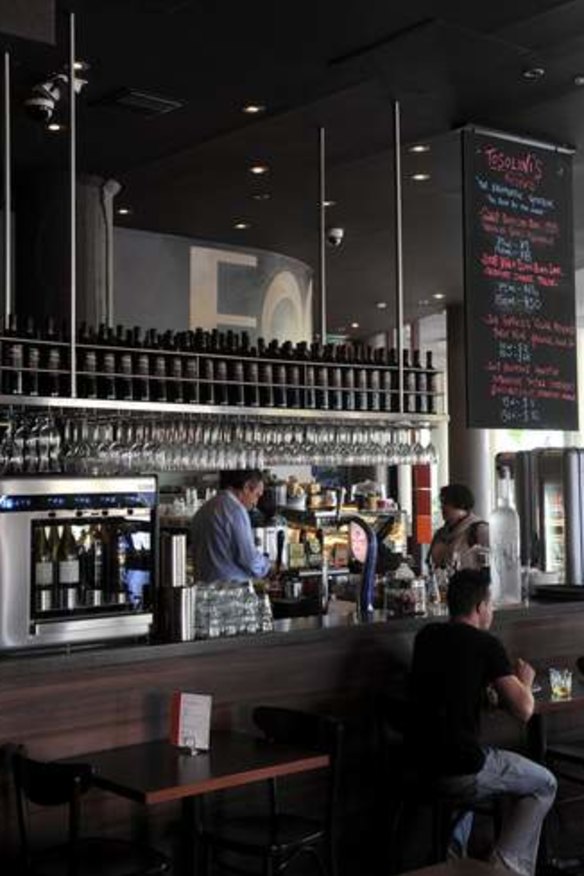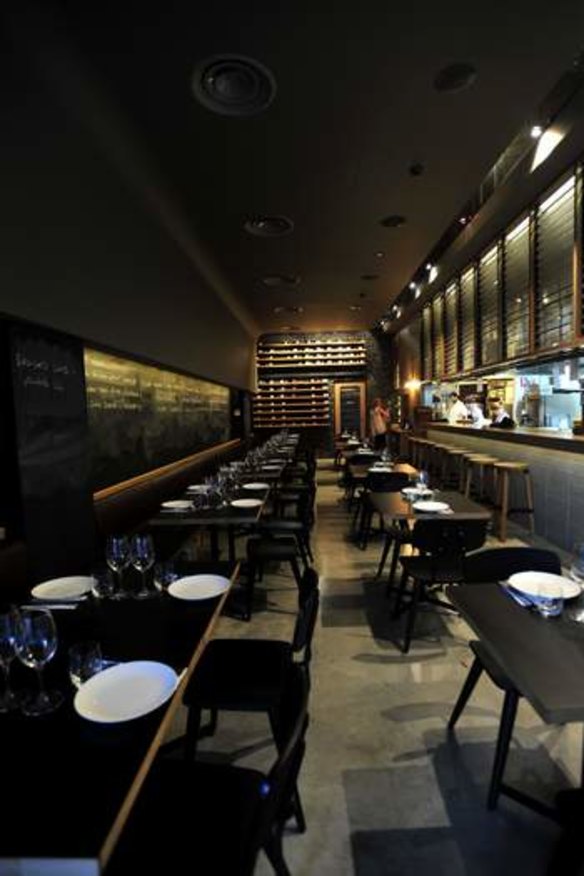Let's hear it for the noise
It's not just about food - a restaurant's sound can impact on a patron's experience, too, <b>Tom McIlroy</b> writes.

The right choice from Canberra's best culinary offerings might once have been about an exciting menu, quality produce, great service and word-of-mouth. But as interior design, loud music and hungry patrons converge in the capital dining scene, could noise levels be the latest criteria to make or break restaurants?
Related stories:
Din and dinner: Are our restaurants just too noisy?

For many, the challenge of creating an engaging atmosphere sometimes means loud music and ambient noise from patrons and staff reverberating around spaces with hard surfaces of wood, tiles, concrete and glass.
With all that noise, Canberra restaurants are using architectural and interior design solutions to increase comfort and to adhere to industry standards.
After more than 20 years as a fixture of Canberra dining, Carlo Tosolini moved to quiet down his iconic Tosolini's restaurant in the city through the installation of noise-absorbing baffles on the ceiling.

''When we first opened up, we were very busy and people said it was loud but I thought it was to do with a honeymoon period,'' he says. ''I was watching the bank balance more then and not paying much attention to it.''
After becoming more established and paying attention to the levels of noise in the restaurant, Tosolini says he worked with interior decorators to reduce sound levels in the business using the sound-absorbing panels. ''When we had the baffles installed, I thought 'why didn't I do this sooner?' Compared with anything else you do in restaurants, the cost has been minimal and the feedback is that it has made a big difference.''
With a 200-square-metre space encompassing dining area, kitchen, bar and toilets, Tosolini says the horizontal baffles reduced noise and made dining more comfortable.
''It was in response to some feedback that the noise was loud in here. It's really hard being a customer in your own restaurant so I went to other places to observe things and can see that my clientele base changed somewhat as a result.
''I am across the road from the theatre and I get a lot of older people who want a bit more of a quieter atmosphere as well as businessmen who need a quiet area to have a meeting or chat.''
The issue of noise in restaurants and other workplaces is not just a comfort issue for diners.
ACT WorkSafe legislation includes a designated noise exposure standard of a level of 85 decibels averaged over an eight-hour period for workers. Normal conversation is considered about 60 decibels while some heavy machinery is measured at about 80 decibels. In Victoria and NSW, 85 decibels is the end of the WorkCover safe limit at which employees can complete an eight-hour day without being provided with protective ear covering - not exactly standard issue in kitchens.
But sound might also drive consumer dollars.
The author of In Pursuit of Silence (2010), George Prochnik, reported a 2008 study in France which found louder music also increased consumption of food and alcohol (as reported by thedailybeast.com). Music at 72 decibels saw men consuming an average of 2.6 drinks in half an hour, while 88 decibels saw a spike to an average of 3.4 drinks, with one consumed every 11.47 minutes.
Earlier this year, a group of New York restaurants turned down their music and asked staff to reduce kitchen noise with the idea of improving the hearing and comfort of patrons.
The Turn Down the Volume event saw more than 10 restaurants mute phones, music and even ask staff to pipe down.
One Canberra restaurant reaching for a very different balance when it comes to noise levels is the much-hyped Braddon eatery Eightysix.
Opened this year, owners Sean Royle and Gus Armstrong say they wanted a noise-friendly space from the beginning. ''When we went to our architect to talk about the whole idea of our restaurant, we had a very clear focus about where we wanted to position ourselves in the market and who we wanted to be,'' Royle says.
''A big aspect of that was the music we wanted to play and I guess how we wanted to be true to ourselves. We said to our architect that the most important thing is the acoustics because we won't be able to get away with the music we want to play if all the acoustics are really reverberating and it felt really hollow.''
Both men have made a priority of using hip-hop music to build a vibrant atmosphere as the setting for a busy, fast-paced restaurant. Royle says the L-shaped design - set around an open kitchen and usually filled with loud guests - was created to allow music with sympathetic acoustics. ''Gus and I both really love our hip-hop and while some people might find it really offensive, we just made a decision that we wanted to break the mould a bit. ''We're not trying to say we're the first people ever to have loud hip-hop music playing in restaurants but I think we might be in Canberra.''
Like all risk-taking ventures, the success of Eightysix is to be found in word-of-mouth and the urgency some excited diners bring to returning to the often loud restaurant. ''We spent a lot of money on a stereo that has capabilities to play our type of music without it being offensive. People come in and most of them don't notice the music, unless you listen for it,'' he says.
''We also have people who come in and lose their minds and say it reminds them of going to a house party when they were in year 12. That's kind of what we wanted it to be. We wanted to create emotion. We wanted it to feel like people were walking into our house.''
Royle and Armstrong freely admit their style isn't for everyone and industry practice shows that might be the case.
Stephanie Olsen from Knauf, a manufacturer of sound absorbing plasterboard, says that noise in restaurants had become a growing problem around the world, as sustained financial downturns sees the roll out of restaurants designed for profit, not comfort.
Her company recently launched Dine Hear, a campaign to raise awareness of the issue. ''Architects and restaurant designers used to go to a great deal of trouble to make intimate spaces where people would go to make conversation,'' she says. ''You go to restaurants to be social. These days you often come out none the wiser of what the other person has said.''
She describes a classic fine-dining restaurant of the recent past with drapes by the windows, carpet on the floor, textured wallpaper on the walls and linen on the table. ''All those materials absorb sound,'' she says. ''But they are all expensive to install and maintain. Minimal is much cheaper. But it is very noisy.''
Check out reviews before you head out to eat. If they mention words like ''noisy'' or ''hubbub'', you'll be prepared for what's coming. To avoid noise, ask for a quiet table away from speakers, open kitchens and coffee grinders or head to a more traditional establishments with carpet, curtains and tablecloths.
Restaurateurs wanting to keep the noise down can dampen and disperse sound using physical barriers and alcoves to break up the path of the soundwaves as well as fabrics and soft furnishings. Simply turning down the music could be a cheaper alternative to installing ceiling islands or baffles.
Some might wonder if it's time for the humble tablecloth to make a comeback in Canberra's restaurants? For Eightysix's Sean Royle, the push for his style of ''loud, honest music'' comes from a career of putting up with industry favourites long past their used by date. ''After you work in restaurants for as long as we have, there is only so much Jack Johnson and CafeDel Mar you can listen to … there's only so long you can listen to the same thousand songs.'' He praised restaurants such as Sydney's Porteno in Surry Hills for achieving realistic noise levels and comfortable atmosphere. Royle says Eightysix makes little effort to hide its volume.
''There's a lot of noise that comes from the kitchen, because it's not hidden by anything. Everything is on display, with heaters contributing to the noise and exhaust fans and everything. There has been no effort to take the noise out of the kitchen because we wanted it to be a transparent place in that way.''
With the sounds of a busy kitchen preparing for dinner in the background, he laughs when asked whether a loud atmosphere is working.
''People do seem to like what's going on here, so that's something,'' he says.
>> Do you like or hate the noise? Have your say in the comments secion.
>> Tom McIlroy is a staff reporter.
Restaurant reviews, news and the hottest openings served to your inbox.
Sign up